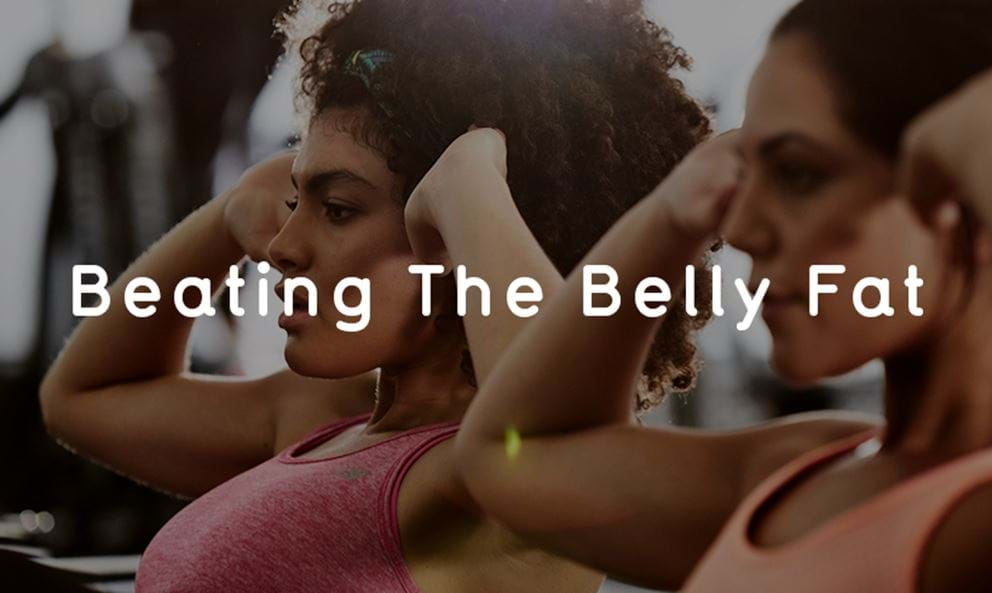Beating the Belly Fat

Reducing “stubborn belly fat” is probably one of the most common goals when it comes to health and fitness. No matter what supplements you take, no matter what exercises you do, it can sometimes seem as if you’re making no progress at all in firming up your abs.
But like any other fitness challenge, the key to defeating belly fat is as straightforward as knowing what works, sticking with it, and getting rid of what doesn’t.
Here’s a look at some of the things you might be doing which could be hindering you from achieving a flatter stomach, and some of the things you should be doing right, in order to tackle the love handles.
Doing it wrong: crunches and sit-ups
On the surface, doing ab work to try and get rid of your belly fat seems pretty reasonable. Exercise burns calories, crunches and sit-ups make your abs ache, so that means they probably do something to shift that fat, right?
Nope.
Ab exercises are great – for strengthening and developing your abs. And of course, like all exercise, they burn calories. The thing is, they burn calories in an overall sense across your whole body – not for the specific area that’s being trained.
The idea of using isolation exercises to burn fat away from one area of the body at a time is called “spot reduction”, and it’s an old myth that’s been debunked by study after study.[1]
When it comes to beating back the belly fat with exercise, focus on workouts that will help to reduce your body fat levels overall – like sprint intervals, for example.
Doing it wrong: sugary sports drinks
The sports drink industry does a pretty good job of marketing itself, with flashy claims that each drink will give you the energy (and usually the right balance of electrolytes) to kick your workouts up to the next level, burn fat, increase your performance in the gym and so on.
And while it’s true that during serious endurance events (like marathons) sugary drinks might help to provide an extra burst of energy, they’ll only be harmful to your overall fat loss goals.
Studies have shown conclusively that refined sugar (especially in the form of high fructose corn syrup) sends your liver into overdrive and causes your body to store the excess energy away as fat.[2]
Some research even seems to suggest that these processed sugars are more likely to increase belly fat, specifically.[3]
Doing it right: eating plenty of protein
When people think “high protein diet” they usually imagine bodybuilders trying to pack on slabs of muscle. In fact, a high protein diet is also one of the best ways of encouraging fat loss.
Research from the University of Missouri has shown that frequent high protein meals reduce food cravings and increase feelings of satiety during weight loss attempts.[4] Other studies have found that the energy burned by the body while digesting food (thermogenesis) is doubled on a high protein diet compared to a high carb diet[5], and also that high protein diets caused test subjects to consume around 441 fewer calories per day.[6]
As if that wasn’t enough, one study published in Nutrition & Metabolism found that high protein intake was inversely correlated with abdominal fat.[7]
In other words, the more quality protein you eat, the less belly fat you’re likely to have.
Doing it right: going low carb
Low carb diets might not be for everyone, but the science is pretty clear that going low carb – at least for a while – is a great way of turbo-charging for your fat loss efforts.
Studies have shown that low carb diets result in about twice as much overall fat loss as low-fat diets do (even calorie-restricted low-fat diets),[8][9] but more interestingly, research has also shown that low carb diets seem to target belly fat specifically – especially in women.[10]
Doing it right: eating more (viscous) fibre
Increasing your fibre intake is often suggested as a way of promoting fat loss, but the type of fibre is important.
Viscous fibre (the type that absorbs water and sits in your gut) has been shown to significantly slow digestion and increase feelings of fullness throughout the day.[11] That’s a great benefit when dieting, of course, but it seems that viscous fibre may be a great weapon against belly fat specifically, not just total body fat overall.
A five-year study published in the journal Obesity found that viscous fibre intake was linked specifically to fat loss in the abdominal region, but not a reduction of fat stores under the skin. [12]
[1] https://www.ncbi.nlm.nih.gov/pubmed/23222084
[2] http://diabetes.diabetesjournals.org/content/54/7/1907.short
[3] http://www.jci.org/articles/view/37385
[4] https://www.ncbi.nlm.nih.gov/pubmed/20847729
[5] https://www.ncbi.nlm.nih.gov/pubmed/11838888
[6] http://ajcn.nutrition.org/content/82/1/41.abstract
[7] http://nutritionandmetabolism.biomedcentral.com/articles/10.1186/1743-7075-9-5
[8] https://academic.oup.com/jcem/article-lookup/doi/10.1210/jc.2002-021480
[9] http://www.nejm.org/doi/full/10.1056/NEJMoa022637
[10] http://nutritionandmetabolism.biomedcentral.com/articles/10.1186/1743-7075-1-13
[11] http://jn.nutrition.org/content/130/2/272S.full
[12] https://www.ncbi.nlm.nih.gov/pmc/articles/PMC3856431/#


